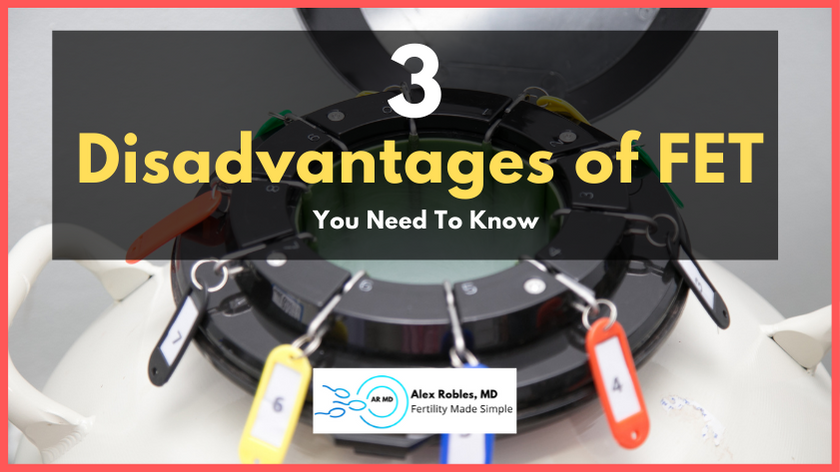In this article, you will learn the disadvantages of a frozen embryo transfer cycle.
Thankfully, the advantages will far outweigh the disadvantages in most patients undergoing in vitro fertilization.
Let’s get started.

What Is Frozen Embryo Transfer?
A frozen embryo transfer is a process in which the embryos generated from an IVF cycle are cryopreserved (frozen) instead of being transferred right away.
A frozen embryo must be warmed (aka thawed) before it can be transferred back into your uterus at a later date.
What are the disadvantages of a frozen embryo transfer?
There are three main disadvantages with a frozen embryo transfer (FET cycle):
- Longer time to conception
- It can be more costly
- Embryos may not survive the freezing and warming process
Let’s go over this one by one.
1. Frozen embryo transfers delay conception
The main disadvantage of a frozen embryo transfer is that it takes longer than a fresh embryo transfer to complete.
A fresh transfer occurs as early as 3-5 days after the egg retrieval, while a frozen transfer won’t happen earlier than 4-6 weeks after the IVF cycle.
Here is an example of what it can all look like.
- January 1st: Day 1 of your period
- January 3rd: First Day of IVF injections
- January 12th: Final Day of Stimulation – Trigger Shot Administered
- January 14th: Egg Retrieval
- January 19-21: All Blastocysts Embryos Are Frozen
- January 28th: Day 1 of your subsequent cycle / period.
- January 30th: First Day of FET cycle
- February 13th: Day of Progesterone Start
- February 18th: Frozen Embryo Transfer (of a Blastocyst)
In contrast, if you chose to have a fresh cycle, you would have had a blastocyst transfer on January 19th and a pregnancy test on January 28th.
I go over an entire FET cycle timeline in this post.
Your reproductive endocrinologist may also use this time to do any further work-up that hadn’t been optimized or done before, such as a uterine cavity evaluation.
If an abnormality is found, this will delay your transfer a bit more.
2. Frozen embryo transfers can be more costly
A FET requires an additional treatment cycle after the IVF cycle, and this usually means more office visits, more ultrasound monitoring, more blood work, and more medications.
Fortunately, these visits are less complex, and the medications used are less costly and have fewer side effects.
In addition, there is the cost of warming the embryo and preparing you for the transfer itself.
3. Embryo freezing and thawing survival rates
Lastly, FET cycles require that your embryo undergo vitrification (freezing) followed by warming (thawing).
In a small percentage of cases, some embryos do not survive the thawing process. Thankfully, data indicate that over 90% of embryos survive a freeze/thaw cycle.
In my experience, that number is close to 95-98%.
Frozen embryo transfer advantages
Now let’s talk about the benefits or advantages of FET cycles.
The five biggest advantages are:
- Allows for scheduling of your family planning
- Reduces the need for additional IVF cycles
- Allows for preimplantation genetic testing
- It decreases the risk of OHSS
- It improves endometrial synchrony
1. Frozen embryo transfers are great for patient scheduling
The main advantage of a frozen embryo transfer is that it allows you to plan ahead, and you can undergo a FET at a time of your convenience.
For example, you can undergo an IVF cycle to freeze embryos now, but schedule your transfer six months from now after a big trip or event.
2. Reduces the need for additional IVF treatment cycles
A FET helps avoid going through another IVF cycle if you happen to generate multiple embryos and you desire more than one child.
Frozen embryos can be preserved indefinitely and are usable to you and your partner at any point.
3. Allows for preimplantation genetic testing
Preimplantation genetic testing (PGT) is a technique in which we biopsy the embryos to test for chromosomal abnormalities such as Down syndrome.
Many early miscarriages or birth defects result from some genetic abnormality, and with genetic testing, we can prevent a large proportion of these.
With a fresh embryo transfer, there isn’t time to biopsy the embryo and get the results back in time before doing the transfer.
4. Decreases the risk of ovarian hyperstimulation syndrome
A small percentage of women will develop ovarian hyperstimulation syndrome during their IVF stimulation cycle.
This condition is exacerbated if you undergo a fresh embryo transfer as OHSS is worsened by beta-hCG, the pregnancy hormone.
4. It improves endometrial synchrony
Lastly, a frozen embryo transfer helps synchronize the uterus (or the endometrial lining) with when the embryos are transferred.
Oftentimes, an IVF cycle can throw off the timing of the hormones necessary for implantation to occur. A FET helps ensure that we place the embryo in the uterus at the right time.
I go over all of these advantages in more detail in Freeze All IVF Cycles.
Is IVF more successful with frozen embryos?
Pregnancy rates and live birth rates (aka the chances of success) are similar for frozen and fresh embryos in almost all other patient groups.
With that said, you may not be eligible for a fresh transfer if you are:
- at high risk of OHSS
- desire genetic testing of your embryos
- your lining or hormone levels are suboptimal for a transfer
What are frozen embryo transfer success rates?
Success rates of good quality embryos (blastocysts) can reach 50-60%.
These numbers are heavily influenced by:
- patient age at the time of embryo cryopreservation,
- embryo quality,
- the day the embryo made it to blast stage (day 5,6, or 7)
- and patient diagnosis.
Here are some recent studies: [1] [2] [3]
Other Related Questions
What are the risks of freezing embryos?
Freezing a blastocyst embryo is a reasonably safe procedure with very minimal risk.
The main risk of freezing embryos is that they will not survive the thaw.
If you only had one embryo frozen, then this means you would have to undergo another ovarian stimulation (IVF) cycle to generate more.
Do frozen embryos have health problems?
As far as we can tell, babies generated from frozen embryos have similar outcomes to babies born from fresh embryo transfer cycles.
The overall risk of these cancers is about 0.02% in naturally conceived babies. This study found a risk of about 0.04% in those conceived from frozen embryo transfer.
Although this represents a relative risk increase of about 50%, the absolute increase is minimal, and the conditions are rare. In addition, this study demonstrates an association or a correlation, which does not represent causation.
More research is needed to confirm and expand on these findings.
How many days after my period is the frozen embryo transfer?
A frozen embryo transfer usually occurs ~21-24 days after the start of your period.
In general, you will begin monitoring on day 3 of your period, allow the uterine lining to grow for about 14 days, and take progesterone supplementation for 3-5 days before the transfer.
Some patients may need more time to allow the lining to grow. In these situations, may delay the transfer by several days.
I go over the entire FET cycle Timeline in this post.
How long can embryos be frozen and still be viable?
Embryos can remain frozen in liquid nitrogen indefinitely for future use.
As long as the IVF laboratory follows proper storage protocols, your embryos will remain viable for years and years.
Final Words On The Pros and Cons of Frozen Embryo Transfers
As you can see, there are some advantages and disadvantages of using frozen embryos.
For the most part, you can rest assured that frozen cycles are a safe and effective procedure that can help you optimize the timing of your pregnancy.
Do you still have any other questions regarding fresh cycles vs. frozen cycles?
Other Related Posts on The IVF Process
- The IVF Frozen Embryo Transfer Timeline Explained (Step by Step)
- When Do You Check A Pregnancy Test After An Embryo Transfer
Make An Appointment With Dr. Robles To Discuss Your Fertility Options Today!

Alex Robles, MD
Dr. Alex Robles is a Spanish-speaking Latino-American Reproductive Endocrinologist and Infertility specialist in New York City, and a board-certified OBGYN. He has a special interest in health, lifestyle, & nutrition. Make an appointment with Dr. Robles to discuss your fertility options today!
References:
- Han AR, Park CW, Lee HS, Yang KM, Song IO, Koong MK. Blastocyst transfer in frozen-thawed cycles. Clin Exp Reprod Med. 2012;39(3):114-117. doi:10.5653/cerm.2012.39.3.114
- Roque M, Haahr T, Geber S, Esteves SC, Humaidan P. Fresh versus elective frozen embryo transfer in IVF/ICSI cycles: a systematic review and meta-analysis of reproductive outcomes. Hum Reprod Update. 2019 Jan 1;25(1):2-14. DOI: 10.1093/humupd/dmy033. PMID: 30388233.
- Bdolah Y, Zeimet R, Aizenman E, Lossos F, Abram TB, Shufaro Y. Frozen-Thawed Embryo Transfer Success Rate is Affected by Age and Ovarian Response at Oocyte Aspiration Regardless of Blastomere Survival Rate. JABRA Assist Reprod. 2015 Nov 1;19(4):210-5. DOI: 10.5935/1518-0557.20150041. PMID: 27203194.
- Veleva Z, Orava M, Nuojua-Huttunen S, Tapanainen JS, Martikainen H. Factors affecting the outcome of frozen-thawed embryo transfer. Hum Reprod. 2013 Sep;28(9):2425-31. DOI: 10.1093/humrep/det251. Epub 2013 Jun 11. PMID: 23756705
- Hargreave M, Jensen A, Hansen MK, et al. Association Between Fertility Treatment and Cancer Risk in Children. JAMA. 2019;322(22):2203–2210. doi:10.1001/jama.2019.18037
